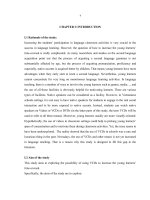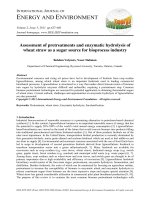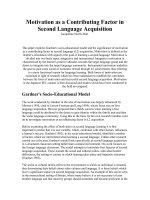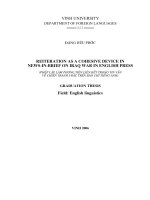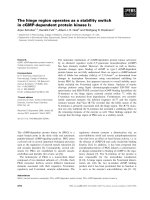Salmon protein hydrolysate as a protein source in feed for young pigs j v nørgaard, k blaabjerg, h d poulsen
Bạn đang xem bản rút gọn của tài liệu. Xem và tải ngay bản đầy đủ của tài liệu tại đây (273.58 KB, 6 trang )
Animal Feed Science and Technology 177 (2012) 124–129
Contents lists available at SciVerse ScienceDirect
Animal Feed Science and Technology
journal homepage: www.elsevier.com/locate/anifeedsci
Salmon protein hydrolysate as a protein source in feed for young pigs
J.V. Nørgaard ∗ , K. Blaabjerg, H.D. Poulsen
Department of Animal Science, Aarhus University Foulum, P.O. Box 50, DK-8830 Tjele, Denmark
a r t i c l e
i n f o
Article history:
Received 12 October 2011
Received in revised form 1 August 2012
Accepted 8 August 2012
Keywords:
Fish meal
Fish protein concentrate
Pigs
Salmon protein hydrolysate
Soy protein concentrate
a b s t r a c t
Salmon protein hydrolysate (SPH) is made from fresh by-products from farmed salmon
that are minced and acidified to hydrolyse proteins into peptides and free amino acids. The
objective of this study was to evaluate SPH in young pigs compared to soy protein concentrate (SPC), fish meal (FM) and combinations hereof. Five diets were composed, all fulfilling
the nutrient recommendations for young pigs. All diets contained 172 g soy bean meal/kg.
One diet was supplemented with 123 g SPH/kg, and equivalent protein was supplied as SPC
or FM in two other diets. Two diets were composed by combining half the amount of SPH
and SPC or half the amount of SPH and FM. One week after weaning, one hundred individually housed pigs were allocated to one of five diets (n = 20) and fed ad libitum for four
weeks. Pigs fed the SPH and SPH + FM diets ate 12–14% more (P<0.05) than pigs fed the
SPC diet, but the results on gain and feed utilization was not significantly different among
treatments. No differences were observed in faeces characteristics when scored by visual
judgment during two 5-d periods. In conclusion, pigs responded equally to diets containing
SPH and FM, and SPH resulted in greater feed intake than SPC.
© 2012 Elsevier B.V. Open access under CC BY-NC-ND license.
1. Introduction
The use of highly digestible and palatable feedstuffs is important in diets for young pigs. Especially the challenge of
handling diarrhoea problems after weaning have focused on minimizing the level of dietary crude protein (CP) and the
amount of undigested crude protein (e.g. Bikker et al., 2006; Nyachoti et al., 2006; Heo et al., 2008). Processing of soy bean
meal (SBM) into soy protein concentrate (SPC) or soy protein isolate results in protein sources well tolerated by young pigs
(Li et al., 1991a). Soy bean protein sources often have an amino acid composition somewhat different from the ideal amino
acid profile (Boisen et al., 2000), but the amino acid composition of fish products is often complementary to that of vegetable
protein sources, and the use of fish meal (FM) in weaner diets is therefore common.
The salmon protein hydrolysate (SPH) (H-pro, Hordafor DK, Aabybro, Denmark) used in this study was in the form of
concentrated salmon silage produced by acid hydrolysis of salmon protein. In the process, fresh by-products from farmed
salmon are minced and mixed with formic acid until the pH value has stabilized between 3.5 and 4.0. At this pH range,
proteases in the salmon tissue such as pepsin are able to hydrolyse the proteins into peptides and free amino acids.
The suitability of fish protein hydrolysates is well described for fish (Espe et al., 1999; Refstie et al., 2004; Hevrøy et al.,
2005), where it is known to be a good and easily digestible protein supplement. The explanation for the positive effects of
the fish protein hydrolysate on animal performance may be the high content of short peptides and free amino acids which
Abbreviations: ADG, average daily gain; Ca, calcium; CP, crude protein; DM, dry matter; FCR, feed conversion ratio; FM, fish meal; HPLC, high performance
liquid chromatography; P, phosphorus; SBM, soy bean meal; SEM, standard error of mean; SID, standardized ileal digestible; SPC, soy protein concentrate;
SPH, salmon protein hydrolysate.
∗ Corresponding author. Tel.: +45 87157816; fax: +45 87154249.
E-mail address: (J.V. Nørgaard).
0377-8401 © 2012 Elsevier B.V. Open access under CC BY-NC-ND license.
/>
J.V. Nørgaard et al. / Animal Feed Science and Technology 177 (2012) 124–129
125
Table 1
Analysed chemical composition (g/kg as-fed) of wheat, barley, toasted dehulled soy bean meal (SBM), salmon protein hydrolysate (SPH), soy protein
concentrate (SPC), and fish meal (FM).
Item
Wheat
Barley
SBM
SPH
SPC
FM
Dry matter
Gross energy, MJ
Crude protein (CP)
CP digestibilitya
Crude fat
Lysine
Methionine
Cysteine
Threonine
Valine
Isoleucine
Leucine
Phenylalanine
Histidine
859
15.8
101
904
22
3.1
1.6
2.4
3.0
4.7
3.3
6.8
4.6
2.6
871
16.3
111
914
26
4.2
1.8
2.5
3.8
5.8
3.8
7.8
6.0
2.7
882
17.5
478
954
28
29.4
6.7
7.1
19.3
24.0
22.3
36.0
23.5
13.2
478
10.3
346
978
65
22.7
8.8
3.3
14.1
15.8
13.0
22.5
12.8
7.8
912
18.1
532
951
21
32.6
6.5
7.2
20.9
26.1
24.4
39.3
27.2
14.4
924
19.9
697
959
113
50.4
19.3
5.4
28.8
35.3
29.8
49.1
26.8
14.7
a
In vitro ileal digestible protein (g/kg crude protein) (Boisen and Fernández, 1995).
are palatable and more readily absorbed than intact protein without preceding digestion by pancreatic proteases (Gilbert
et al., 2008). Furthermore, SPH may exhibit some biological activity as peptides from fish protein hydrolysates are thought to
act immune-stimulating when used in aquaculture (Gildberg et al., 1996; Kotzamanis et al., 2007; Taheri et al., 2010). These
aspects of SPH have not been studied in pigs, and the documentation on growth performance is sparse. It is hypothesized
that pigs respond equally well to SPH as to FM, which is often used as a positive reference in experimental diets for piglet.
The objective of the present study was to evaluate effects on feed intake, feed utilization and growth of young pigs
receiving SBM containing diets supplemented with SPH, FM, SPC or equal amounts of SPH + FM or SPH + SPC.
2. Materials and methods
2.1. Animals, diets and protocol
A total of 100 crossbred (Landrace-Yorkshire × Duroc) female and castrated male pigs at the same proportion were weaned
at 27.6 ± 1.6 d of age and individually housed in pens with visual and physical contact to neighbouring littermates. The pens
comprised one-third concrete flooring and two-thirds plastic flooring which permitted drainage. Five similar rooms of 10
pens were used twice, i.e. the experiment was divided into two periods. During the first wk after weaning, the pigs were fed
a standard diet containing 1.0 g zinc/kg without growth promoters.
Seven days after weaning, the pigs weighed 9.0 kg (SEM, 0.3 kg) and were allocated to one of the five treatments. The
treatments were balanced according to sex and weight. The experiment started one wk after weaning to assure that all pigs
consumed sufficient feed and were adapted to the individual pens. Pigs were provided feed ad libitum for 28 d. The feed was
supplied twice daily, with feed dispensers adjusted on a regular basis to minimize feed spillage. The pigs had permanent
access to fresh water from nipple drinkers. The experiment complied with the Danish Ministry of Justice Law no. 382 (June
10, 1987), Act no. 726 (September 9, 1993), concerning experiments with animals and care of experimental animals.
The chemical composition and the in vitro CP digestibility (Boisen and Fernández, 1995) of the main ingredients were
determined before diets were optimized (Table 1). Five diets with different main protein sources were composed (Table 2). All
five diets contained 172 g dehulled SBM/kg and were supplemented up to 170 g SID CP/kg with either SPH (H-pro, Hordafor,
Aabybro, Denmark), SPC (HP 200, Hamlet Protein, Horsens, Denmark), FM (FF Classic, FF Skagen, Skagen, Denmark) or a
combination of these protein sources giving raise to SPH + SPC and SPH + FM diets, where SPH, FM and SPC contributed
with equal amounts of SID protein. The contribution from the sum of SPH, SPC and FM to the total content of dietary CP
was from 17 to 22 percent. The five diets were optimized to contain identical levels of net energy (9.45 MJ/kg as-fed) and
main nutrients according to the Danish requirements (Jørgensen and Tybirk, 2008). Therefore, the diets contained similar
concentrations of essential nutrients per kg diet as-fed.
2.2. Registrations and faeces scoring
Pigs were weighed at d 0, 14 and 28 of the experimental period, and the accumulated feed intake was registered for the
periods d 0 to 14 and 14 to 28. Faeces characteristics were evaluated twice during five consecutive days from d 6 to 10 and d
13 to 17 of the experiment. By visual judgment, the faeces were given one of four scores: 0, normal/firm consistency; 1, soft
consistency; 2, thin/sloppy consistency, or 3, watery consistency. The scores 2 and 3 were evaluated as diarrhoea, and score
3 pigs were treated for diarrhoea with injections of Clamoxyl Vet (150 mg/ml amoxicillintrihydrate, Orion Pharma Animal
Health, Nivå, Denmark) for three days as prescribed by the veterinarian. The general health status was recorded daily.
126
J.V. Nørgaard et al. / Animal Feed Science and Technology 177 (2012) 124–129
Table 2
Composition and calculated chemical composition (g/kg, as-fed basis) of experimental diets containing salmon protein hydrolysate (SPH), soy protein
concentrate (SPC), and fish meal (FM).
Ingredient
Wheat
Soy bean meal, dehulled
Barley
SPH
SPC
FM
Animal fat
Calcium carbonate
Mono-calcium phosphate
Vitamin-mineral premixa
Salt
l-Lysine HCl (780 g/kg)
dl-Methionine (990 g/kg)
l-Threonine (980 g/kg)
l-Tryptophan (980 g/kg)
Phytase (Natuphos 5000)
Calculated chemical composition
Dry matter
Crude ash
Crude fat
Crude protein
SID crude proteinb
SID lysine
SPH
SPC
FM
SPH + SPC
SPH + FM
494
172
150
123
–
–
26
15.5
7.5
4.0
2.5
3.4
0.6
0.8
0.6
0.2
562
172
150
–
65
–
11
16.1
9.5
4.0
3.6
4.0
1.2
1.1
0.4
0.2
598
172
150
–
–
48
1.0
13.6
5.6
4.0
2.5
3.6
0.7
1.0
0.5
0.2
528
172
150
62
32
–
18
15.8
8.5
4.0
3.0
3.7
0.9
1.0
0.5
0.2
546
172
150
62
–
24
13
14.5
6.6
4.0
2.5
3.5
0.6
0.9
0.6
0.2
826
54.5
53.2
196
170
11.4
875
56.6
33.8
196
171
11.4
872
52.1
28.3
198
171
11.4
850
55.5
43.4
196
171
11.4
849
53.3
40.8
197
171
11.4
a
Trouw Nutrition Denmark A/S. Provided per kg diet: 10,000 IU vitamin A, 2000 IU vitamin D3 , 94 IU vitamin E, 2.4 mg vitamin K3 , 2.4 mg vitamin B1 ,
4.8 mg vitamin B2 , 2.4 mg vitamin B6 , 0.02 mg vitamin B12 , 12 mg d-panthotenic acid, 26 mg niacin, 0.2 mg biotin, 85 mg ␣-tocopherol, 200 mg Fe (Fe(II)
sulphate), 165 mg Cu (Cu(II) sulphate), 200 mg Zn (Zn(II) oxide), 56 mg Mn (Mn(II) oxide), 0.3 mg KI, 0.3 mg Se (Se-selenite).
b
SID, standardized ileal digestible.
2.3. Analysis
Dry matter (DM) content was determined for diets and faeces by oven drying at 103 ◦ C for 20 h. Gross energy was
measured using bomb calorimetry (Calorimeter 6300, Parr Instrument Company, Moline, USA). Crude protein content (total
nitrogen × 6.25) in urine was analysed by the Dumas method (Hansen, 1989) and in diets and faeces by a modified Kjeldahl
method (AOAC 984.13). Crude fat was extracted with petroleum ether after hydrochloric acid hydrolysis (Procedure B,
Regulation EC 152/2009). Amino acids were hydrolysed for 23 h at 110 ◦ C with or without performic acid oxidation (Directive
98/64/EC). In vitro ileal digestibility of protein was estimated as described by Boisen and Fernández (1995). Molecular weight
distribution of the solubilised protein in SPH was determined by using high performance liquid chromatography (HPLC).
Samples were mixed and centrifuged for 10 min at 3000 × g in a buffer containing 0.1 M sodium chloride, 0.3% sodium dodecyl
sulphate (SDS) and 0.001 M sodium azide before injection into the HPLC fitted with a TSK-G 2000 SW gel permeation column
(7.5 mm × 300 mm) equilibrated with the same buffer at pH 6.8. The flow rate was set at 0.5 ml/min at 2413 kPa, and peptides
were detected with a Perkin Elmer Series 200 UV/VIS detector at 220 nm.
2.4. Calculations and statistical analysis
Animal performance data were statistically analysed by the MIXED procedure of SAS (Littell et al., 2002) according to a
model including diet (diet 1 to 5), sex (castrate, female), the interaction term diet × sex and the initial weight used as a covariate. Room (room 1 to 5), period (1, 2; rooms were used twice), the interaction terms room × period, room × period × diet,
room × period × sex, and room × period × diet × sex were handled as random variables.
Faeces score data are presented as the distribution of scores during the two evaluation periods from d 6 to 10 and from 13
to 17. The distribution of days on the four faeces scores were analysed using the GLIMMIX procedure of SAS (SAS Institute,
1999) with a multinomial distribution (a generalization of the binomial distribution) and a cumulative logit link function
(i.e. the response was restricted to one of a finite number of ordinal values). The model included diet (diet 1 to 5), score
day (d 6 to 10, or d 13 to 17), the interaction term diet × score day, and the initial weight as a covariate. Room (room 1 to
5), the interaction term room × period (1, 2; rooms were used twice) and pig were handled as random effects (Littell et al.,
2002). Statistical significance was accepted at P<0.05 and tendencies at P<0.15. Presented data are least squares means and
standard error of mean (SEM).
J.V. Nørgaard et al. / Animal Feed Science and Technology 177 (2012) 124–129
127
Table 3
Average daily feed intake (ADFI), average daily gain (ADG) and feed conversion ratio (FCR) of pigs.a,b
Item
SPH
SPC
FM
SPH + SPC
SPH + FM
SEM
P value
ADFI, g, d 1–14
ADG, g d 1–14
FCR, g/g, d 1–14
ADFI, g, d 14–28
ADG, g, d 14–28
FCR, g/g, d 14–28
ADFI, g, d 1–28
ADG, g, d 1–28
FCR, g/g, d 1–28
542
417
1.31
968
749
1.33
759y
583
1.32
494
384
1.30
858
663
1.32
668x
527
1.29
519
429
1.23
920
722
1.28
721xy
577
1.25
524
408
1.30
867
699
1.29
691xy
561
1.28
536
429
1.25
927
727
1.28
745y
586
1.27
25
23
0.05
44
35
0.06
29
22
0.03
0.45
0.38
0.29
0.28
0.31
0.83
0.08
0.19
0.38
x,y
Means within rows without a common superscript differ (P≤0.05).
Diets differing primarily in protein sources: salmon protein hydrolysate (SPH), soy protein concentrate (SPC) and fish meal (FM).
b
Values are least squares means and standard errors of the means. n = 20.
a
3. Results
The proportion of water soluble proteins was analysed in SPH to 293 g/kg as-fed, i.e. 85% of the total amount of CP. The
molecular weight distribution of the water solubilised protein fraction in SPH showed a fraction of 81% below 1000 Da, a
fraction of 14% between 1000 and 10,000 Da, and a fraction of 5% above 10,000 Da. This indicates that the majority of the
protein fraction was in the form of di-, tri- and oligo peptides as well as free amino acids.
In general, pigs maintained good health during the experiment. No significant differences were found between pigs fed
SPH and FM (Table 3). From d 1 to 28, pigs fed the SPH and SPH + FM diets ate 12–14% more (P<0.05) than pigs fed SPC diet,
but ADG and FCR did not differ significantly among treatments.
Faeces characteristics were evaluated from d 6 to 10 and from d 13 to 17. Neither the first (P=0.51) nor the second (P=0.42)
evaluation period showed a difference between diets during the distribution of days where pigs were given the different
scores (Table 4).
4. Discussion
Only very little is published on the response to SPH in pigs. The feeding of salmon head protein hydrolysate to piglets
should be limited to 100 g/kg or less for early weaned pigs (Husby, 1991). The use of fish silage from mackerel added formic
acid for 20–55 kg pigs was not limiting the animal performance at the highest inclusion level of 150 g/kg (Green et al., 1988).
The inclusion level of 123 g SPH/kg used in the present experiment was apparently well tolerated by young pigs.
In aquaculture, fish hydrolysate is well studied and has shown synergistic effects with FM (Espe et al., 1999; Refstie et al.,
2004; Hevrøy et al., 2005; Taheri et al., 2010). Due to the large proportion of low molecular weight peptides, SPH may be
more readily digestible and available for absorption than protein sources containing larger peptides and complex protein
structures (Gilbert et al., 2008). However, the effect of feeding small peptides compared to intact protein has apparently not
been studied in pigs. Marine-derived peptides are furthermore known to possess bioactive properties in humans (Kim and
Wijesekara, 2010), although these effects have not been studied in pigs.
Table 4
Distribution of days with faeces scores.a,b
Day 6–10
Score 0
Score 1
Score 2
Score 3
Day 13–17
Score 0
Score 1
Score 2
Score 3
a
b
c
SPH
SPC
FM
SPH + SPC
SPH + FM
69
28
3
0
73
17
5
5
66
30
2
2
64
30
2
4
73
22
2
3
81
19
0
0
71
28
1
0
76
24
0
0
75
25
0
0
71
29
0
0
P valuec
0.51
0.42
Faeces scores: 0, normal/firm consistency; 1, soft consistency; 2, thin/sloppy consistency, or 3, watery consistency.
Diets differing primarily in protein sources: salmon protein hydrolysate (SPH), soy protein concentrate (SPC) and fish meal (FM).
The P value is based on an F-test for differences in the distribution of days with score 0–3 among the diets.
128
J.V. Nørgaard et al. / Animal Feed Science and Technology 177 (2012) 124–129
The diet based on SPC resulted in the lowest feed intake. This is in agreement with Solá-Oriol et al. (2011), who have
shown that pigs have a great preference for FM compared to other protein sources, but in contrast to Jones et al. (2010)
who, at similar inclusion levels of SPC, found animal performances comparable to pigs fed FM. At high inclusion rates (up
to 286 g SPC/kg) Lenehan et al. (2007) found lower feed intake compared to SBM, but other studies on high levels of SPC
inclusion (241–251 g/kg) have shown better responses to SPC than to SBM, and similar responses than for pigs fed dried
skim milk (Sohn et al., 1994) or dried whey (Li et al., 1991b). The underlying reasons for the results of pigs fed SPC alone or
in combination with SPH are therefore not clear.
The registration of faeces characteristics indicated no diet dependent effect on the incidence of diarrhoea, and the incidence of diarrhoea was in general low. One reason for the low incidence of diarrhoea may be the seven days pre-experimental
period of feeding a zinc-containing diet (1.0 g/kg) which was included to secure that all pigs ate from the beginning of the
experimental period, and pigs have thus already been adapted to the shift from sow milk to dry feed. Another reason may
be that diets had only 171 g SID CP/kg, which is lower than diets reported to cause diarrhoea (Heo et al., 2008; Wellock et al.,
2008a).
5. Conclusions
Salmon protein hydrolysate resulted in animal performances similar to FM. Pigs fed the SPH and SPH + FM containing diets
had greater feed intake than pigs fed the SPC containing diet, but results on gain and feed utilization was not significantly
different among treatments. The incidence of diarrhoea was not affected by the protein source which may be due to relatively
low levels of dietary CP and high health standards of the pigs.
Acknowledgements
This work was funded by Hordafor DK and Aarhus University, Department of Animal Science.
References
AOAC, 2000. Official Methods of Analysis of AOAC International No. 984.13, 17th ed. Association of Official Analytical Chemists International, Gaithersburg,
MD.
Bikker, P., Dirkzwager, A., Fledderus, J., Trevisi, P., le Huërou-Luron, I., Lallás, J.P., Awati, A., 2006. The effect of dietary protein and fermentable carbohydrates
levels on growth performance and intestinal characteristics in newly weaned piglets. J. Anim. Sci. 84, 3337–3345.
Boisen, S., Fernández, J.A., 1995. Prediction of the apparent ileal digestibility of protein and amino acids in feedstuffs and feed mixtures for pigs by in vitro
analyses. Anim. Feed Sci. Technol. 51, 29–43.
Boisen, S., Hvelplund, T., Weisbjerg, M.R., 2000. Ideal amino acid profiles as a basis for feed protein evaluation. Livest. Prod. Sci. 64, 239–251.
Directive 98/64/EC, 1998. Commission Directive 98/64/EC of 3 September 1998 establishing Community methods of analysis for the determination of
amino-acids, crude oils and fats, and olaquindox in feedingstuffs and amending Directive 71/393/EEC. The Commission of the European Communities.
Espe, M., Sveier, H., Høgøy, I., Lied, E., 1999. Nutrient absorption and growth of Atlantic salmon (Salmo salar L.) fed fish protein concentrate. Aquaculture
174, 119–137.
Gilbert, E.R., Wong, E.A., Webb Jr., K.E., 2008. Board-invited review: peptide absorption and utilization: implications for animal nutrition and health. J. Anim.
Sci. 86, 2135–2155.
Gildberg, A., Bøgwald, J., Johansen, A., Stenberg, E., 1996. Isolation of acid peptide fractions from a fish protein hydrolysate with strong stimulatory effect
on atlantic salmon (Salmo salar) head kidney leucocytes. Comp. Biochem. Phys. B 114, 97–101.
Green, S., Wiseman, J., Cole, D.J.A., 1988. Examination of stability, and its effect on the nutritive value, of fish silage in diets for growing pigs. Anim. Feed
Sci. Technol. 21, 43–56.
Hansen, B., 1989. Determination of nitrogen as elementary-N, an alternative to Kjeldahl. Acta Agr. Scand. 39, 113–118.
Heo, J.M., Kim, J.C., Hansen, C.F., Mullan, B.P., Hampson, D.J., Pluske, J.R., 2008. Effects of feeding low protein diets to piglets on plasma urea nitrogen, faecal
ammonia nitrogen, the incidence of diarrhea and performance after weaning. Arch. Anim. Nutr. 62, 343–358.
Hevrøy, E.M., Espe, M., Waagbø, R., Sandnes, K., Ruud, M., Hemre, G.I., 2005. Nutrient utilization in Atlantic salmon (Salmo salar L.) fed increased levels of
fish protein hydrolysate during a period of fast growth. Aquacult. Nutr. 11, 301–313.
Husby, F.M., 1991. Nutritional and Feeding Value of a Salmon Protein Hydrolysate in Diets for Weanling Pigs. Alaska Fisheries Dev. Found. Inc., Anchorage,
USA.
Jones, C.K., DeRouchey, J.M., Nelssen, J.L., Tokach, M.D., Dritz, S.S., Goodband, R.D., 2010. Effects of fermented soybean meal and specialty animal protein
sources on nursery pig performance. J. Anim. Sci. 88, 1725–1732.
Jørgensen, L., Tybirk, P., 2008. Normer for næringsstoffer (Recommendations of Nutrients). Dansk Svineproduktion, Copenhagen, Denmark (in Danish).
Kim, S.K., Wijesekara, I., 2010. Development and biological activities of marine-derived bioactive peptides: a review. J. Funct. Foods 2, 1–9.
Kotzamanis, Y.P., Gisbert, E., Gatesoupe, F.J., Zambonino Infante, J., Cahu, C., 2007. Effects of different dietary levels of fish protein hydrolysates on growth,
digestive enzymes, gut microbiota, and resistance to Vibrio anguillarum in European sea bass (Dicentrarchus labrax) larvae. Comp. Biochem. Phys. A 147,
205–214.
Lenehan, N.A., DeRouchey, J.M., Goodband, R.D., Tokach, M.D., Dritz, S.S., Nelssen, J.L., Groesbeck, C.N., Lawrence, K.R., 2007. Evaluation of soy protein
concentrates in nursery pig diets. J. Anim. Sci. 85, 3013–3021.
Li, D.F., Nelssen, J.L., Reddy, P.G., Blecha, F., Klemm, R.D., Giesting, D.W., Hancock, J.D., Allee, G.L., Goodband, R.D., 1991a. Measuring suitability of soybean
products for early-weaned pigs with immunological criteria. J. Anim. Sci. 69, 3299–3307.
Li, D.F., Nelssen, J.L., Reddy, P.G., Blecha, F., Klemm, R.D., Goodband, R.D., 1991b. Interrelationship between hypersensitivity to soybean proteins and
growth-performance in early-weaned pigs. J. Anim. Sci. 69, 4062–4069.
Littell, R.C., Stroup, W.W., Freund, R.J., 2002. SAS for Linear Models, 4th ed. SAS Inst., Cary, NC.
Nyachoti, C.M., Omogbenigun, F.O., Rademacher, M., Blank, G., 2006. Performance responses and indicators of gastrointestinal health in early-weaned pigs
fed low-protein amino acid-supplemented diets. J. Anim. Sci. 84, 125–134.
Refstie, S., Olli, J.J., Standal, H., 2004. Feed intake, growth, and protein utilization by post-smolt Atlantic salmon (Salmo salar) in response to graded levels
of fish protein hydrolysate in the diet. Aquaculture 239, 331–349.
Regulation 152/2009, 2009. Commission Regulation (EC) No 152/2009. Annex III. Methods of analysis to control the composition of feed materials and
compound feed. H. Determination of crude oils and fats. Procedure B. The Commission of the European Communities.
J.V. Nørgaard et al. / Animal Feed Science and Technology 177 (2012) 124–129
129
Sohn, K.S., Maxwell, C.V., Southern, L.L., Buchanan, D.S., 1994. Improved soybean protein-sources for early-weaned pigs. 2. Effects on ileal amino-acid
digestibility. J. Anim. Sci. 72, 631–637.
Solá-Oriol, D., Roura, E., Torrallardona, D., 2011. Feed preference in pigs: effect of selected protein, fat, and fiber sources at different inclusion rates. J. Anim.
Sci. 89, 3219–3227.
Taheri, A., Kenari, A.A., Motamedzadegan, A., Rezaie, M.H., 2010. The relationship between different protein hydrolysate diets by growth, digestive enzymes
and resistance to an aeromonas salmonicida bacterial challenge in rainbow trout (Oncorhinchus mykiss) alevine. World J. Fish Mar. Sci. 2, 264–274.
Wellock, I.J., Fortomaris, P.D., Houdijk, J.G.M., Kyriazakis, I., 2008a. Effects of dietary protein supply, weaning age and experimental enterotoxigenic
Escherichia coli infection on newly weaned pigs: health. Animal 2, 834–842.
